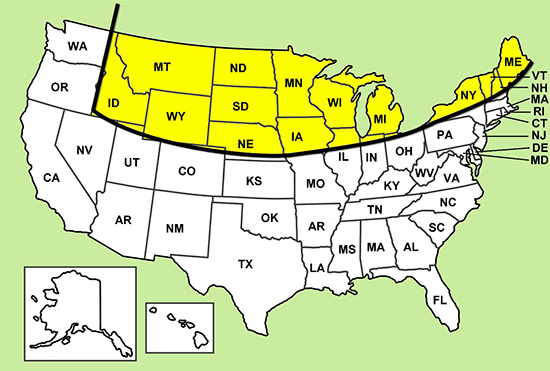With our recent announcement of pre-selected factory-mounted option packages now available for our KM Medium Outdoor Air-Cooled Condensing Units and KV Large Outdoor Air-Cooled Condensing Units, we have received some questions in regard to whether or not our customers need a heated and insulated receiver on their condensing unit.
That’s why we have put together the below FAQs to provide you with a better understanding of if you need this accessory and to help guide you in your decision-making process.
What is a heated and insulated receiver?
Let’s start off by addressing what exactly a heated and insulated receiver is. A heated and insulated receiver is used to add heat to the refrigerant stored in the receiver during the off-cycle of a refrigeration system.
This accessory is available on all KeepRite Refrigeration outdoor air-cooled refrigeration condensing units, selected as a voluntary option at the discretion of the user or as a requirement, with its dependence on other options or the climate in the location of installation.
Our outdoor air-cooled condensing units include an optional heated and insulated receiver, which we recommend for use in climates where the temperature drops below freezing for more than a few hours per year.
What does a heated and insulated receiver do?
The focus of a heated and insulated receiver isn’t so much of what it can do, but rather what it can help to prevent. In a lower ambient, it helps prevent flooded starts and/or frequent cycling of the low-pressure control which can increase the potential for compressor damage.
How does it work?
An electric self-regulating heater is affixed to the external surface of the receiver. The receiver is completely wrapped with 0.5” inch closed-cell foam insulation and sealed with an adhesive to prevent moisture incursion. The heater is powered by the condensing unit control circuit via a normally closed (NC) auxiliary contact attached to the compressor contactor. This circuit allows for the receiver heater to be energized only while the compressor is off.
Because the refrigerant in the receiver is at saturation, the warmed refrigerant will also stay at a higher pressure than it otherwise would if the surrounding ambient temperature was allowed to affect it.
Why would I use it?
While the condensing unit is off, refrigerant liquid temperature and pressure can be greatly affected by the ambient temperature. During long off cycles at low ambient, the refrigerant temperature and resulting pressure can drop close to the ambient temperature acting on the shell of the receiver it’s stored in. When the liquid line solenoid opens, the cold liquid entering the low side of the system may not be at a sufficient pressure to allow for the low-pressure control to close. This can result in a flooded start and or frequent cycling of the low-pressure control resulting in the potential for compressor damage.
Maintaining a warm receiver allows for sufficient liquid pressure to enter the low side of the system, closing the low-pressure control quickly and allowing the compressor to start before the suction line fills with liquid refrigerant.
When or where should I use it? Do I need one?
National Refrigeration and Air Conditioning Canada Corp. suggest that a heated and insulated receiver be implemented on any and all outdoor condensing units that are located in an ambient temperature less than or equal to zero degrees Fahrenheit (0°F) for a few hours per year.
See below (figure #1) for a map indicating locations where this option is recommended. Current ASHRAE weather data was utilized to determine this temperature and location guideline.
This option is required as part of our Limitrol+ floating head pressure control system offered on many outdoor air-cooled condensing units.
Figure #1
The area north of the black line and marked in yellow is the suggested region where a heated and insulated receiver should be implemented on any and all outdoor condensing units.

Which KeepRite Refrigeration Products offer this option?
KeepRite Refrigeration offers the following eight products that include the heated and insulated receiver on the condensing unit:
KEH – Outdoor Air Cooled Hermetic Condensing Units
KEZ – Outdoor Air Cooled Scroll Condensing Units
KES – Outdoor Air Cooled Semi-Hermetic Condensing Units
KQZ – Outdoor Air Cooled Quiet Scroll Condensing Units
KC Combination Condensing Units
KM – Medium Outdoor Air Cooled Condensing Units
KV – Large Outdoor Air Cooled Condensing Units
KF – Outdoor Air Cooled Multi-Compressor Condensing Units
Where can I get more information?
For more information feel free to contact our product specialists dependent on what size condensing unit you have:
For Small Condensing Units: [email protected] 1-844-893-3222 ext. 521
For Medium or Large Condensing Units: [email protected] 1-844-893-3222 ext. 522
You can also visit our Condensing Unit Support page as well as the ASHRAE Climate Data Center to help determine whether or not your location is suitable for KeepRite Refrigeration’s heated and insulated receiver accessory.